|

|
May 2004
|
|
The strange case of the disappearing sparrows
|
|
They learned to co-exist in harmony with us since time immemorial sharing food and shelter with us. They are not as colourful as parrots, as melodious as nightingales or as intelligent as crows. Still there is something in these twittering, chirping dusty brown creatures - the plain Jane females and the males with dark circles under their eyes - that make them endearing. We are talking about the House Sparrow here or Passer Domesticus to give its scientific name.
What prompted this article is their alarming decline in numbers. Long-time residents of Vizag will remember a time when they were all over the place in thousands. Electric cables used to be obliterated by them, trees and backyards were full of them. A species that was once found everywhere in Vizag has become confined to few pockets of the city.
The VizagCityOnline.com team decided to investigate this phenomenon and made a few observations of their own as well as take expert opinion from Asst Prof P.S. Rajashekhar of the Department of Environmental Studies, Andhra University. The main cause for the gradual disappearance of house sparrow, according to Prof Rajasekhar, is the depletion of food resources and loss of habitat. They are finding it increasingly difficult to cope with the rapid changes that are taking place in the city, he says.
House sparrows live in groups and feed on grains, insects, kitchen scrap and flower buds. They prefer thatched houses and bungalows to concrete structures such as flats to build their nests . They lay 3-5 eggs at a time barring no season.
Prof Rajashekhar explains that mono-culture (single variety) grasses that have become a fad and that are grown for beautification by destroying various native varieties of grasses, depletion of other flora and fauna that they depend upon, and the expansion of concrete jungle in the city is disturbing the natural settings required for their survival.
He explains that this is not strictly an urban phenomenon but that even in villages their number is on the decline. The tradition of feeding the birds after harvest as a sign of gratitude is vanishing. Also, as more farmers adopt inorganic farming using more chemical pesticides and fertilisers to improve the yield (even if in the short term), these birds are getting more endangered.
Some farmers consider the sparrow a pest that damages crops and are employing various techniques to get rid of them, but this is a wrong perception says Prof Rajashekhar. On an average each sparrow will eat a staggering figure of 1000 caterpillars per year which is better than a chemical pesticide with harmful side effects.
It doesn't say much for Vizagites when they show little or no concern for this cute little species that is willing to co-exist with us. The next time you can do something to protect them or save their habitat, do so. Vizag would be poorer if they were to become extinct.
|
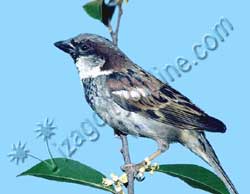 |
| Disappearing
House - Sparrow. |
|

|
| How
long can we survive? |
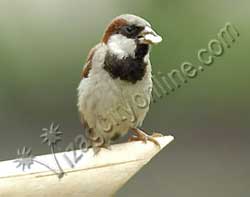
|
| Save Us
! We have every right to share the nature. |
|
|
|
|
Vizagites try to beat the heat!
|
|
With the setting in of the hot summer months the residents of Vizag are
constantly on the lookout for ways to beat the heat. Stifling and
suffocating, the killing heat of the Vizag summer makes one dream of
fruit juices and light clothes, a cool shower or a swim or, perhaps for
those who can afford it, of getting away to the cooler climes of a hill
station.
As the scorching heat catches up on Vizagites, they are looking for
alternatives to beat the heat. But then, what are the alternatives? To
get some idea, the VizagCityOnline.com team went around meeting people
from different walks of life to find out how they were coping.
Bramhaji, an MBA graduate from the relatively affluent class, enjoys his
daily swim at the aqua sports complex while, Kondal Rao, who runs a
finance business, has enrolled his son at a summer camp. Lakshmi, a bank
employee is planning to spend her holidays along with her family at a
hill station. For others of the middle class who can't afford such
luxuries, hanging out at the beach is the only option.
In sharp contrast, is the hardships faced by the slum dwellers of
Sidhardhanagar in Resapuvanipalem who have far more important issues to
worry about than the heat. The municipal corporation authorities,
following a high court order, demolished their homes, no doubt with the
intention of rehabilitating them in 'pucca' houses at a later date. In
the meanwhile, these slum dwellers have been forced to arrange for
temporary shelter. Some have gone to stay with their relatives while
others have to reside on the pavements, underneath the open sky, during
the unbearable heat of a May summer!
One of these slum dwellers, Chittibabu, had this to say: "It
doesn't make much of a difference whether it is summer or winter, we
have to toil throughout the day in the hot sun to earn bread for our
families". He further added, "we are used to these climatic
changes". For him life had to be accepted for what it was. Another
pavement dweller, Ammalamma, while resting on a ramshackle cot under the
shade of a tree, responded in the typical fashion of one resigned to her
fate: "The soothing breeze which comes at intervals is enough to
give us solace" What a difference in circumstance and attitude
between her and Lakshmi the bank employee!
For those of you with the means to beat the heat, spare a thought for
these poor people without even a roof over their heads.
|
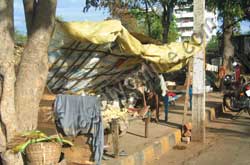 |
| A Slum
Dweller made the Pavement his Home with only the shade of a tree
to cool him! |
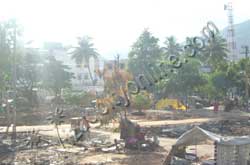 |
| Slum
Dwellers of Sidhardhanagar in Resapuvanipalem living in their
Temporary Shelters |
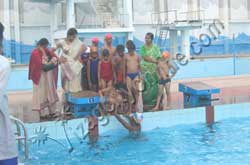 |
| A
better way to cope with the heat for those who can afford it! |
|
|
|
|
Youth delegation led by Vizagite Mr. Ch. Sreenivas Prasad cherishes Pak warmth & hospitality
|
|
The warmth and
hospitality shown recently by Pakistan in welcoming the Indian cultural
delegation certainly testifies to the NDA's claim of the feelgood factor,
says State Secretary of the Youth Hostels Association of India Mr. Ch.
Sreenivas Prasad of Visakhapatnam, who also looks after the city Youth
Hostel here.
He says the objective of the delegation, which was on a trip to the neighbouring country between April 13th to 18th, was to promote peace and international understanding.
The delegation comprised 28 Youth Hostel Association representatives from 14 Indian states including Mr Sreenivas Prasad. The trip went a long way towards quashing general misconceptions about the neighbouring country, he said, since people-to-people contact could best mend soured relations between two nations that share a common history, culture and traditions.
The delegation was welcomed with a performance of Bhangra dancing at the Wagah border. During the trip the delegates also had the opportunity to meet Pak Foreign Minister Khursheed Mehmood Kasuri besides other Pak ministers. Their six-day itinerary covered Lahore, Islamabad, Rawalpindi, Taxila, Murrie and Burban.
Mr Sreenivas, who has
also visited other countries, says the Pak trip was indeed a unique
experience, and would like to visit Pakistan again if he had a chance. |
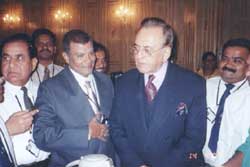 |
| Mr. Ch. Sreenivas Prasad with Mr. Khursheed Mehmood Kasuri, Foreign Minister, Pakistan |
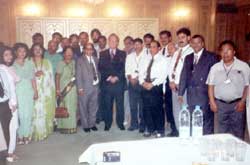 |
| Youth
Delegation meeting at Pakistan. |
|
|
Back
|
|







